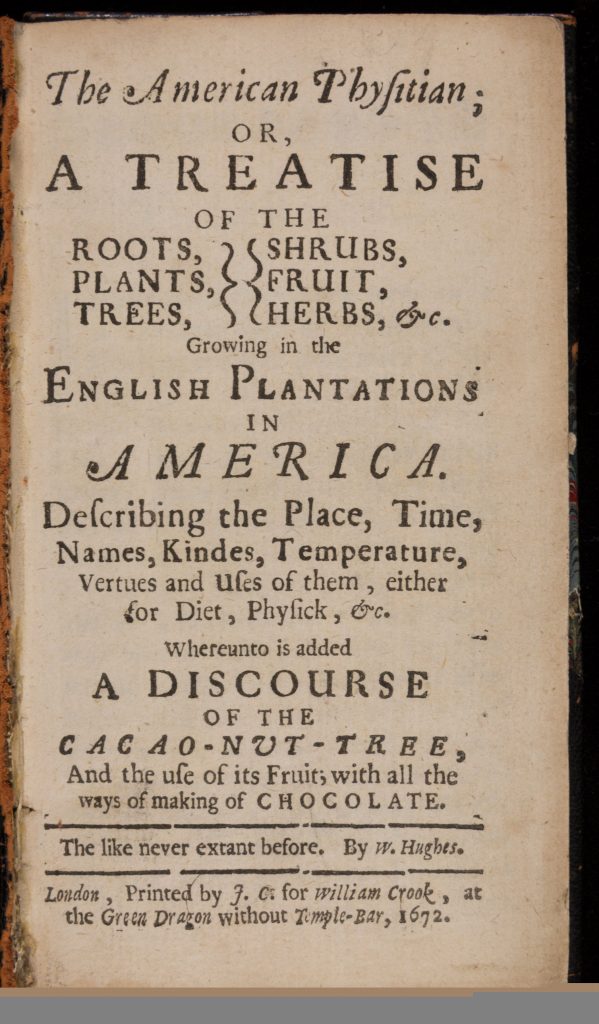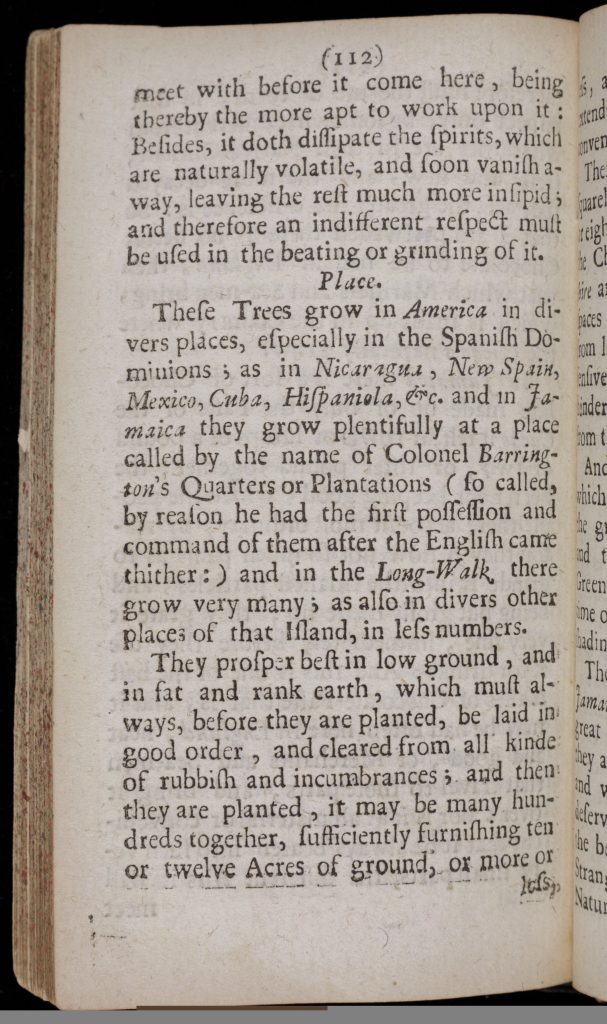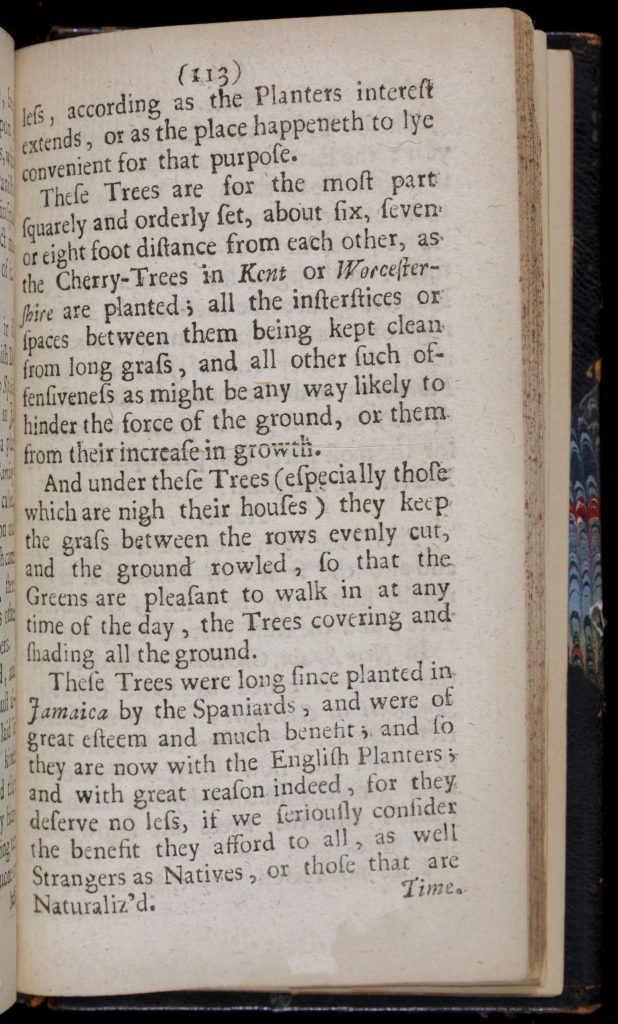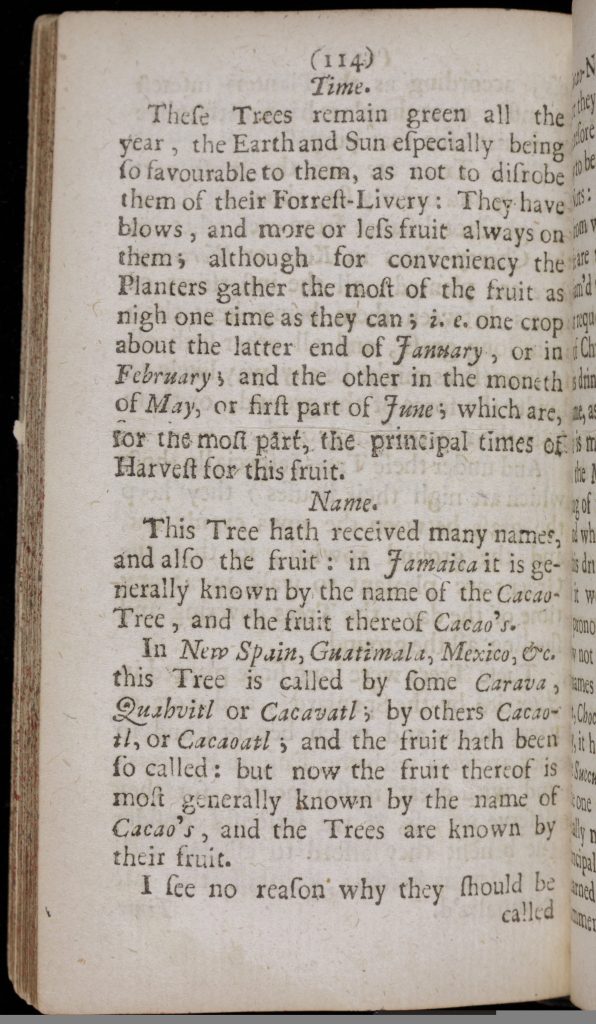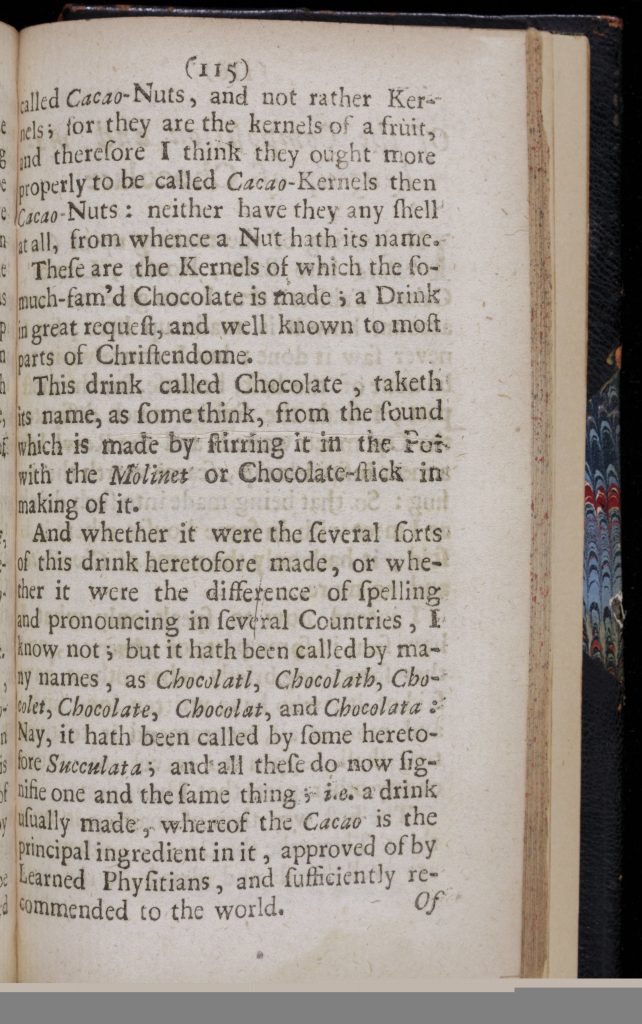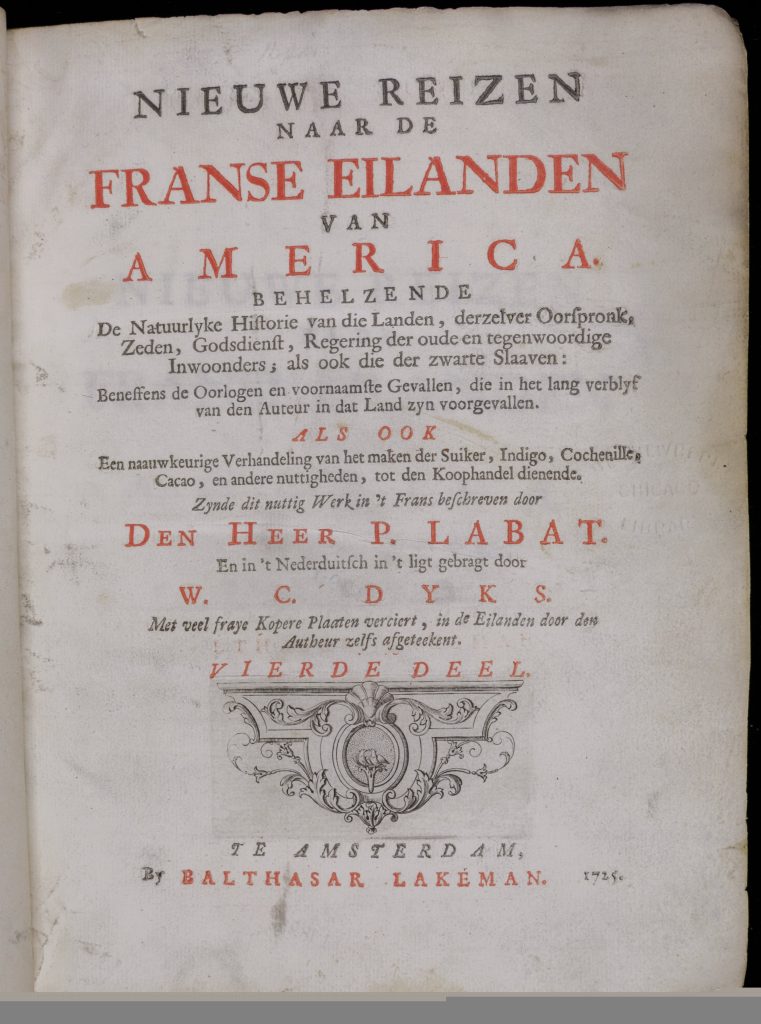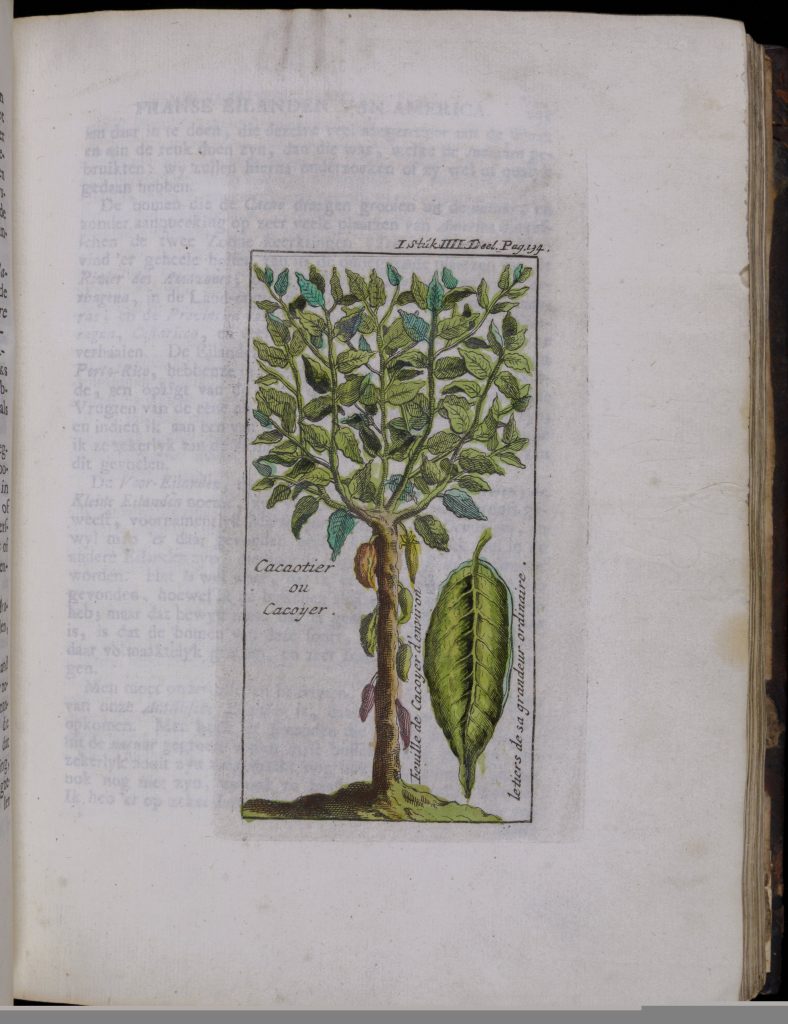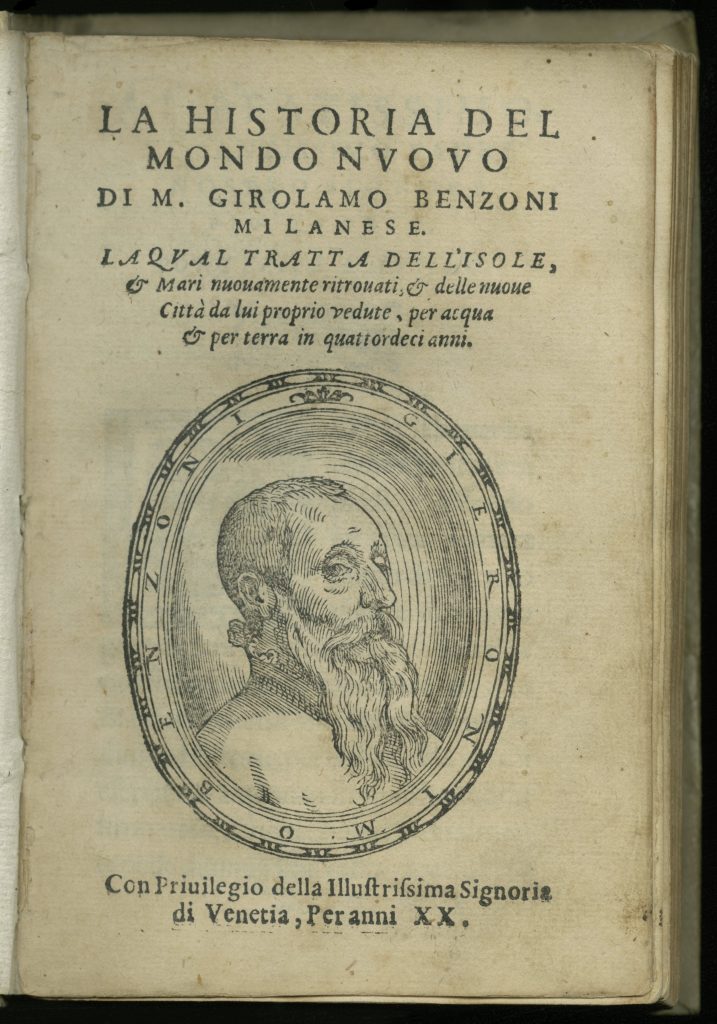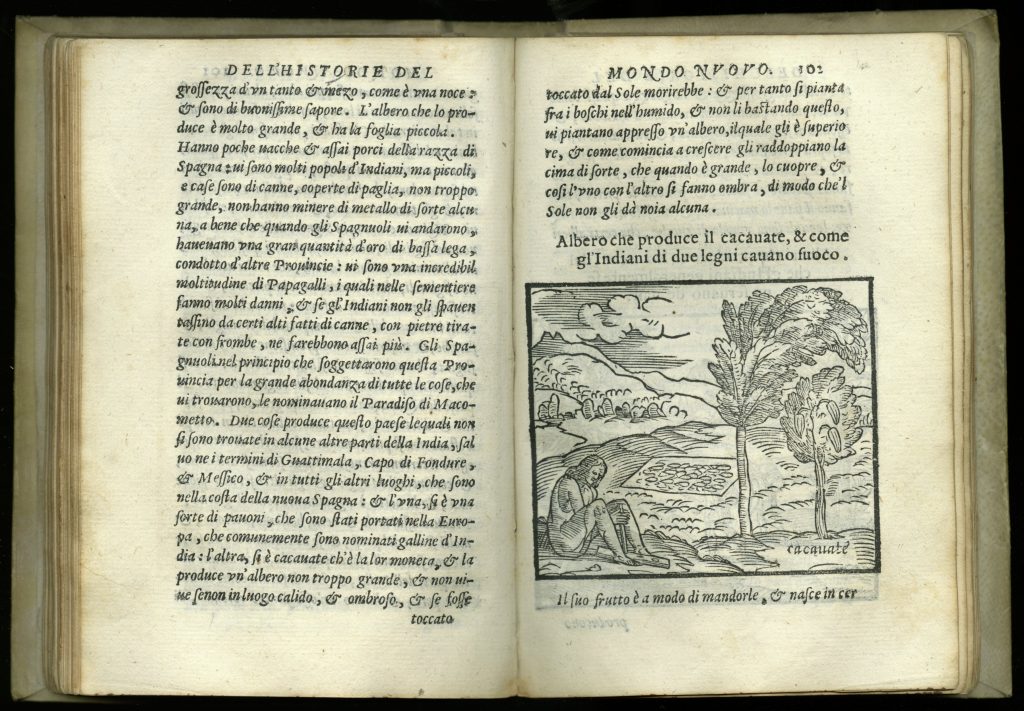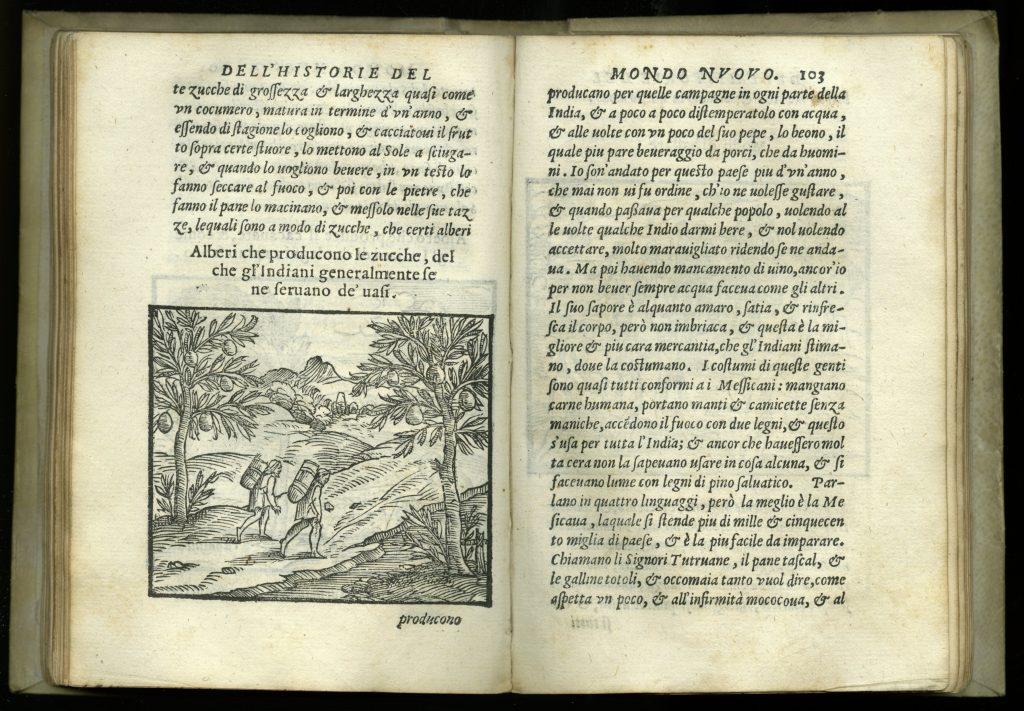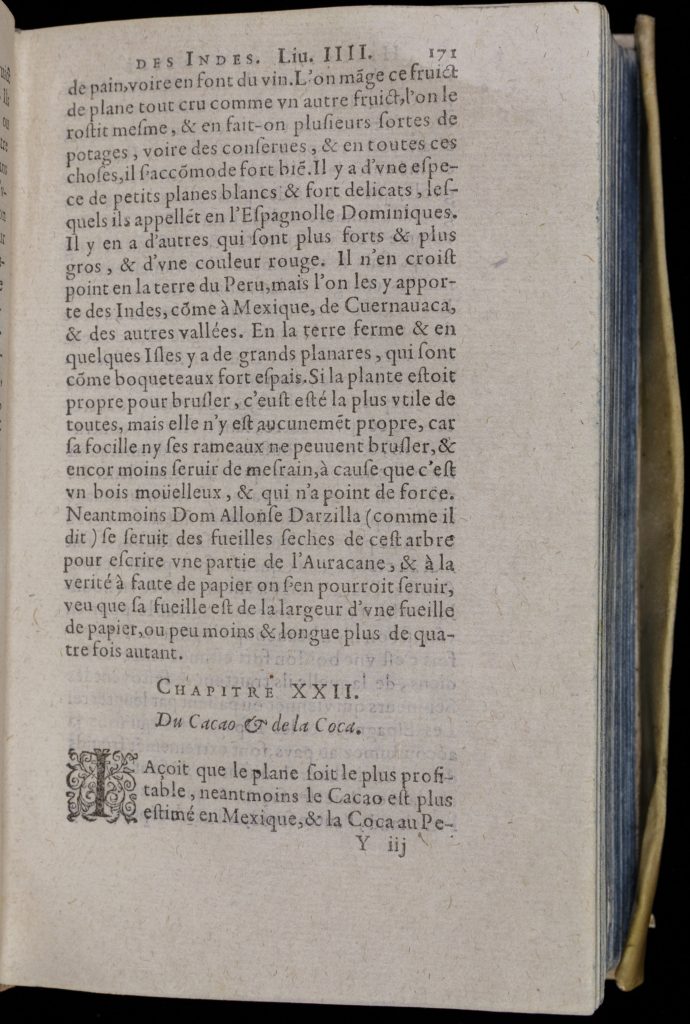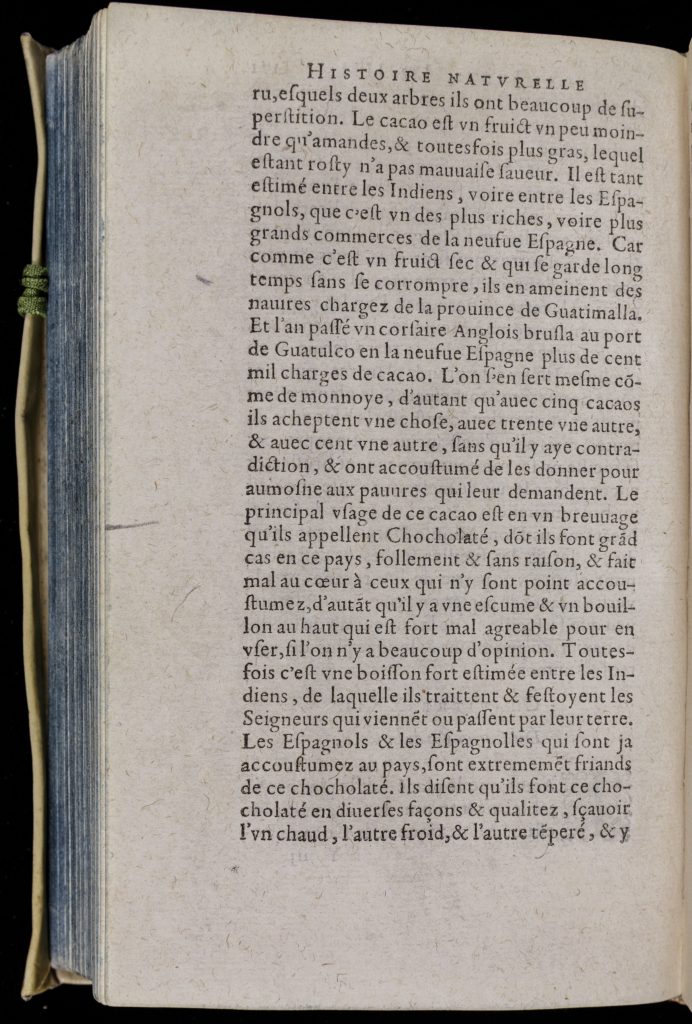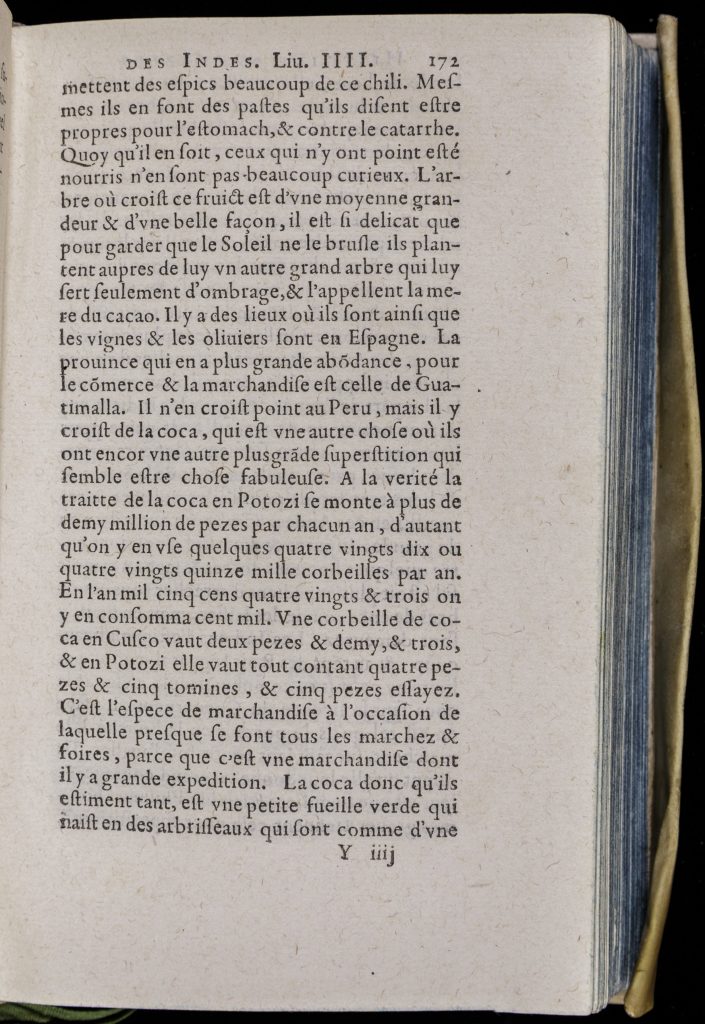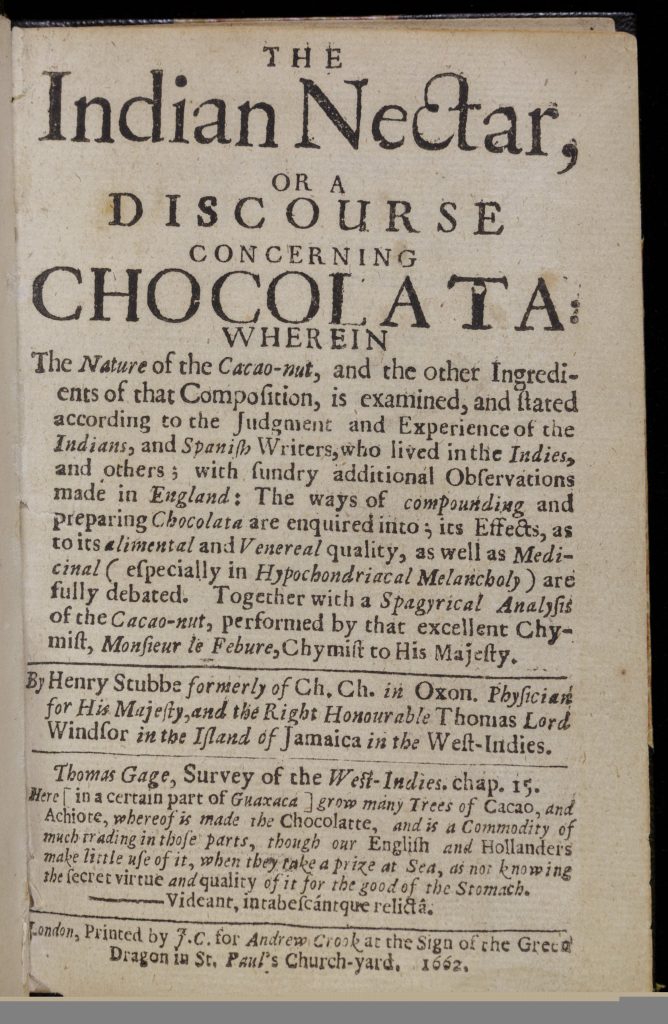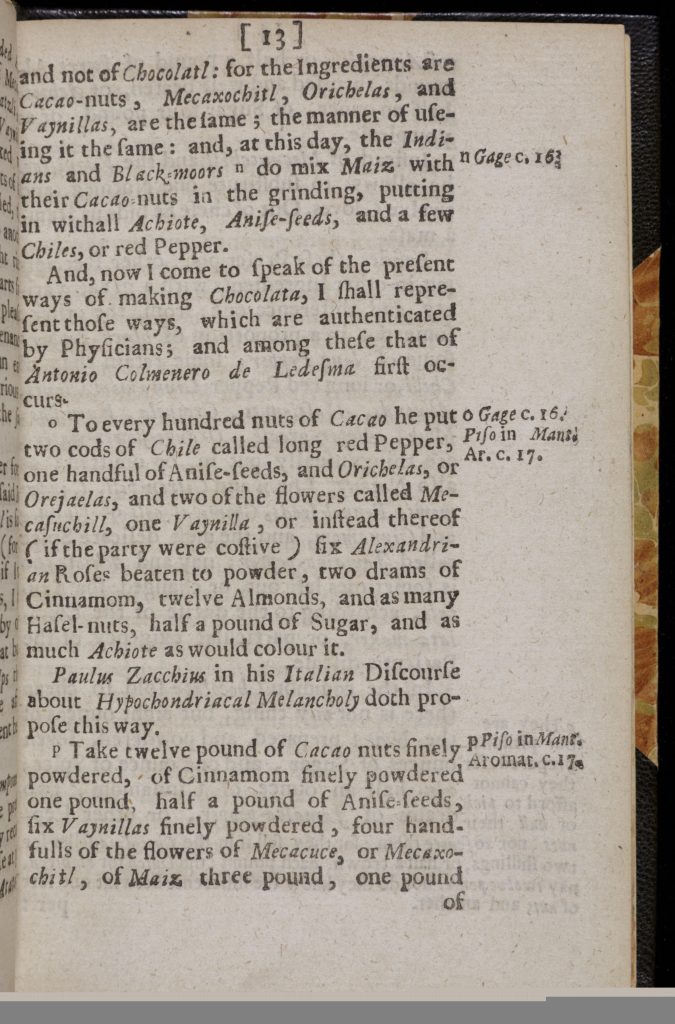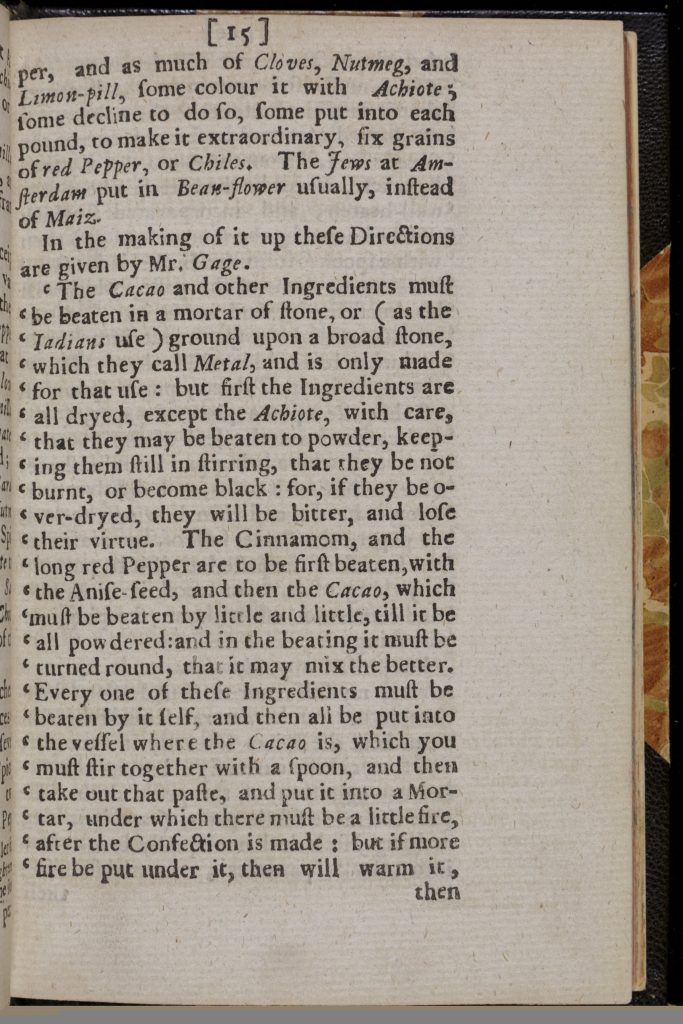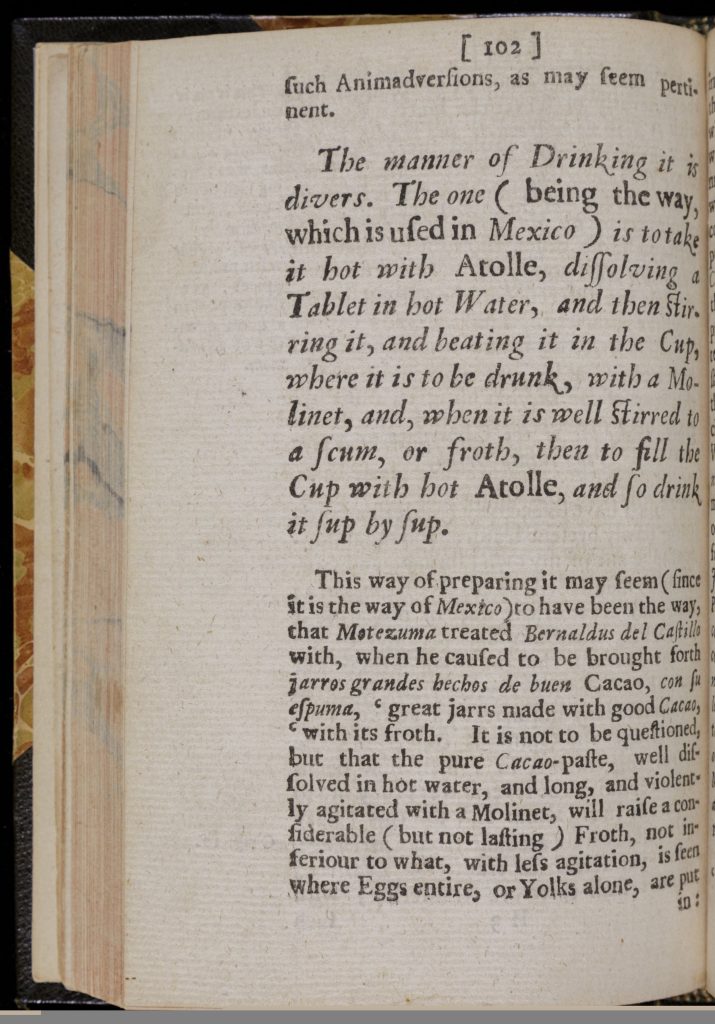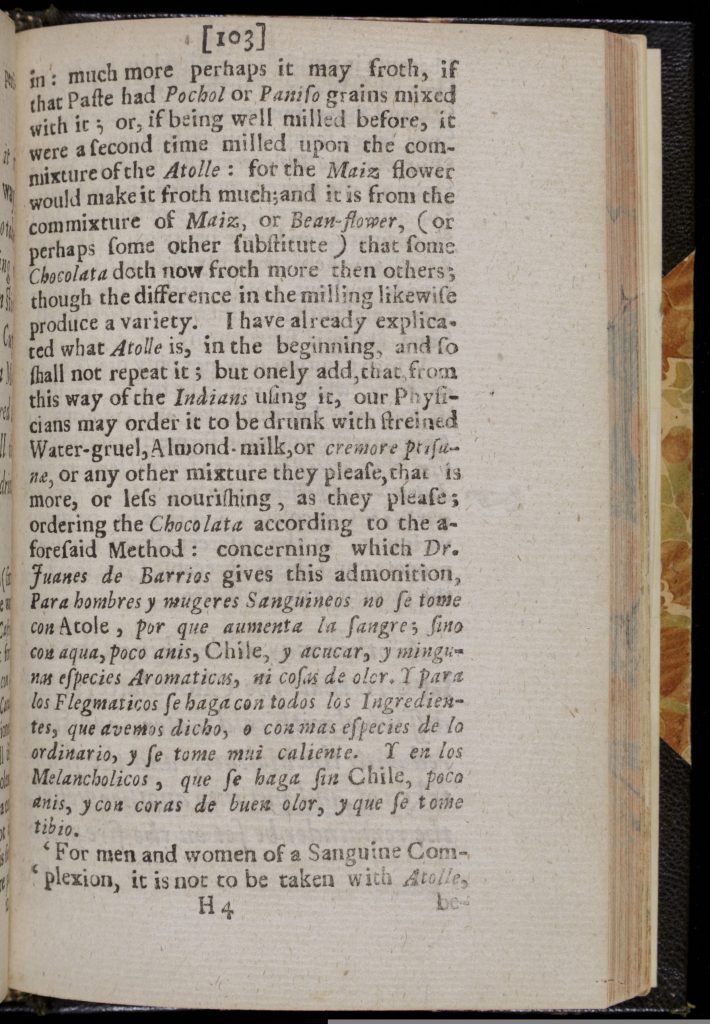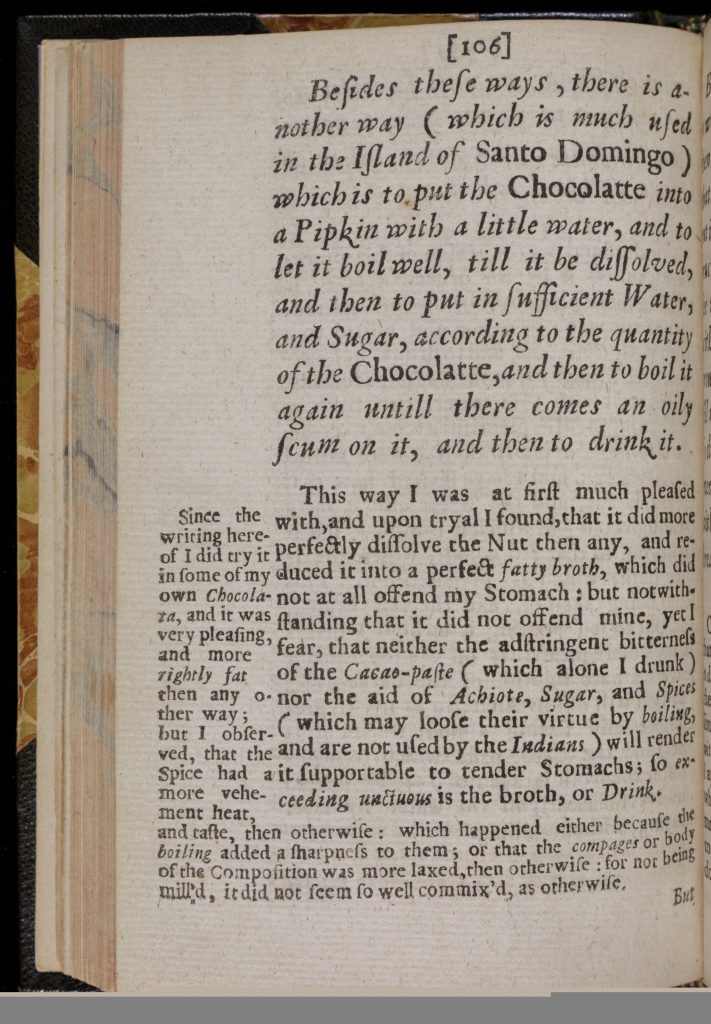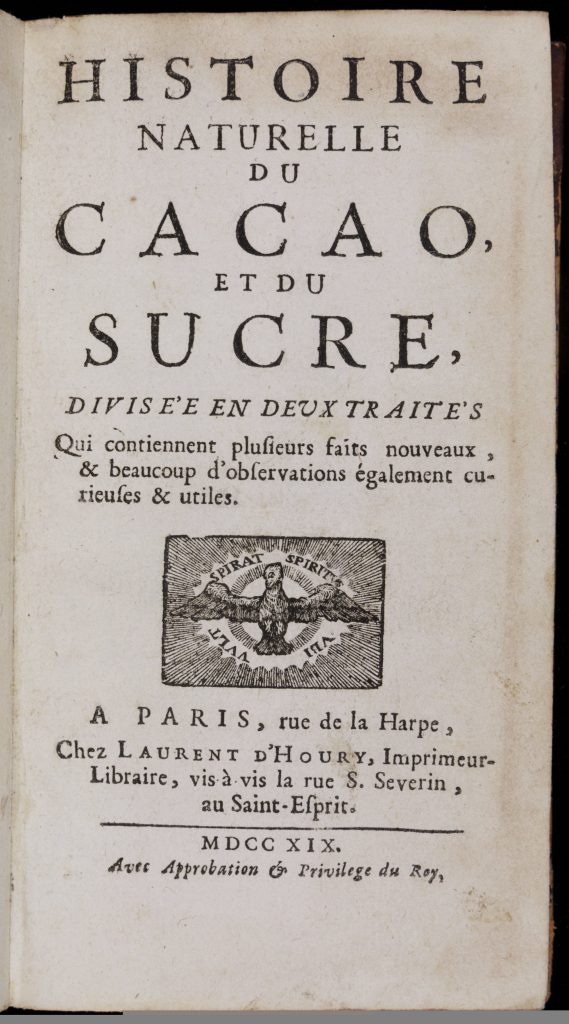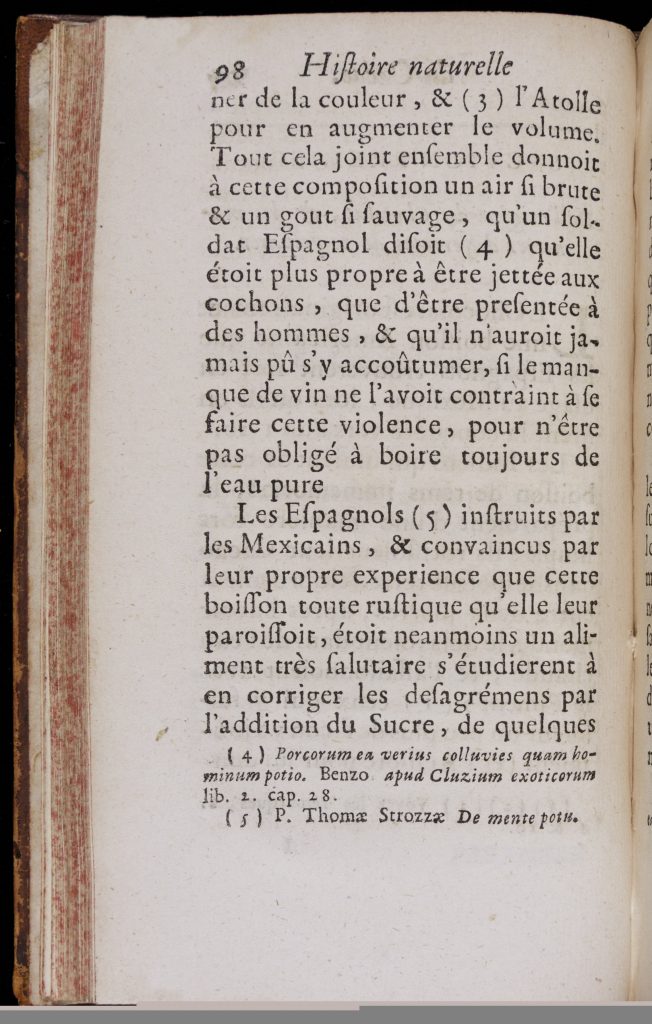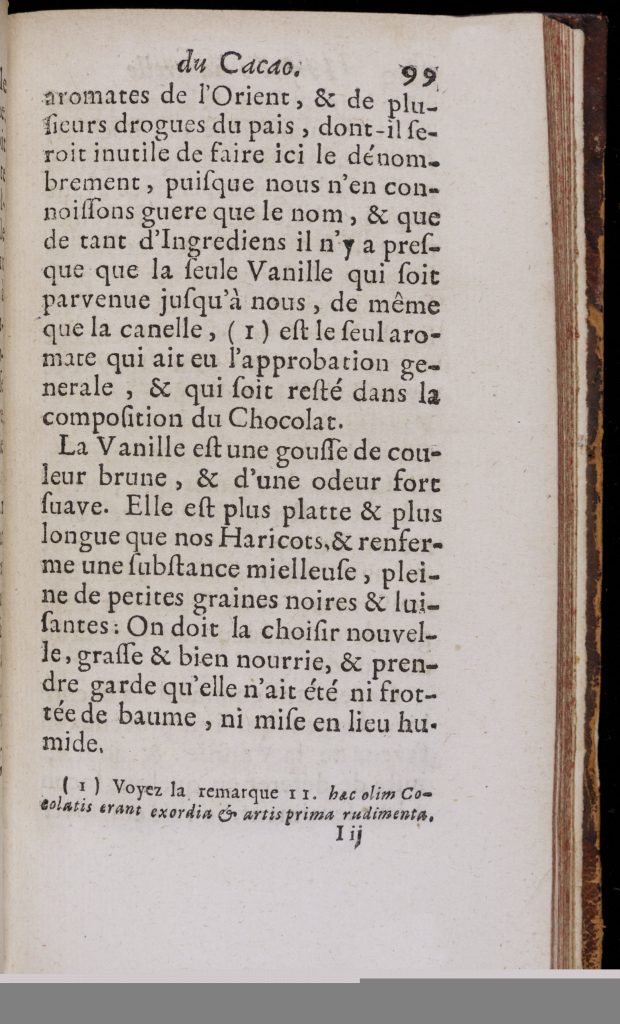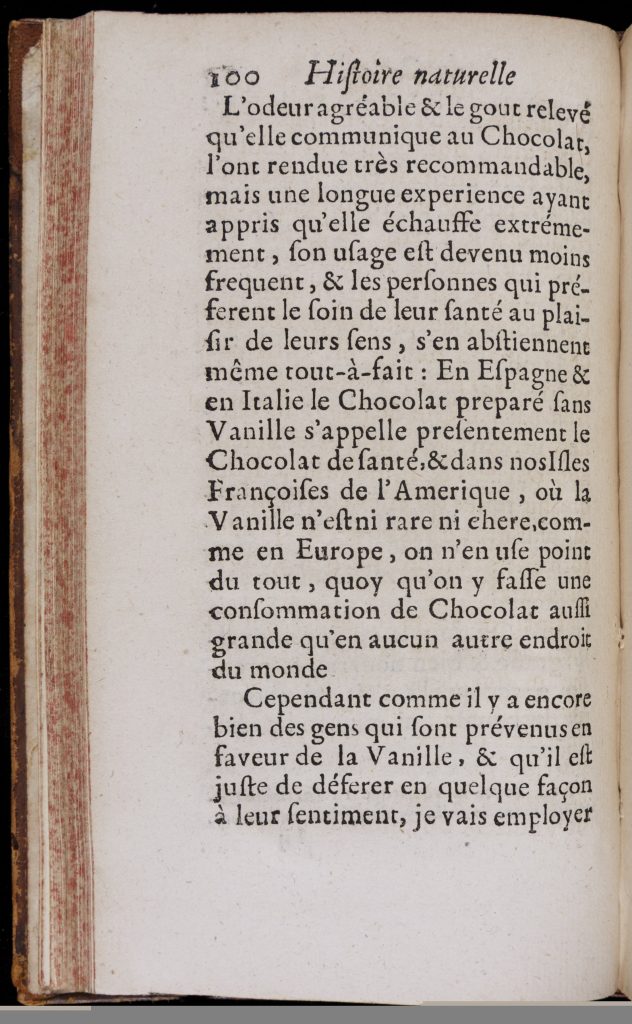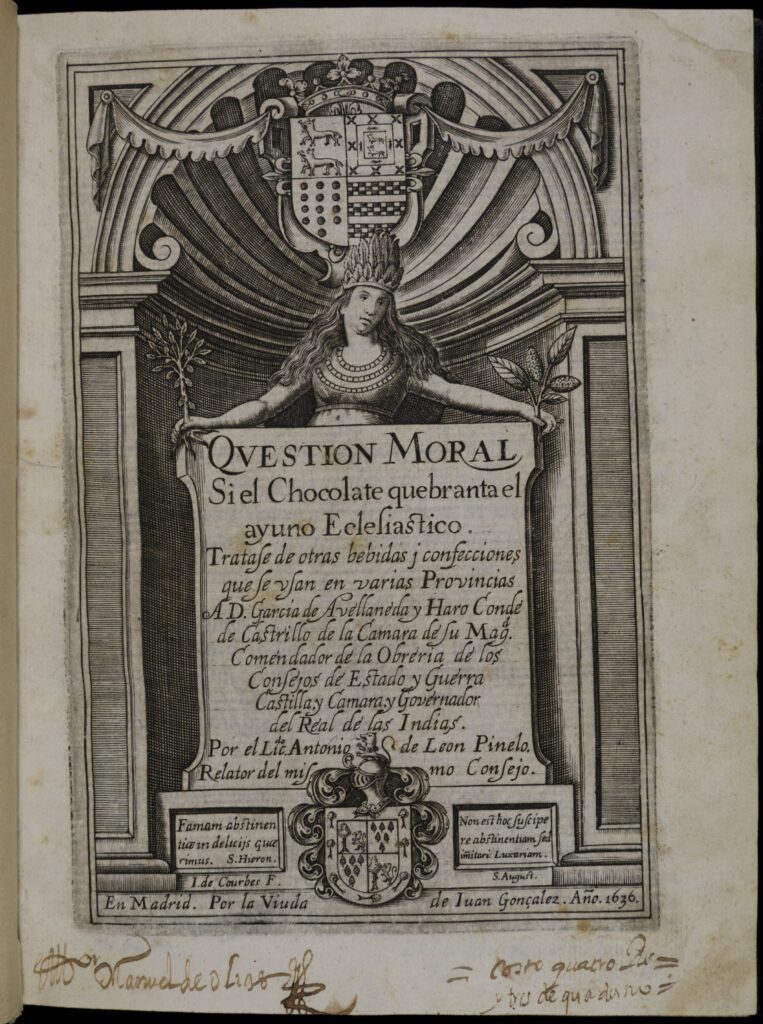Introduction
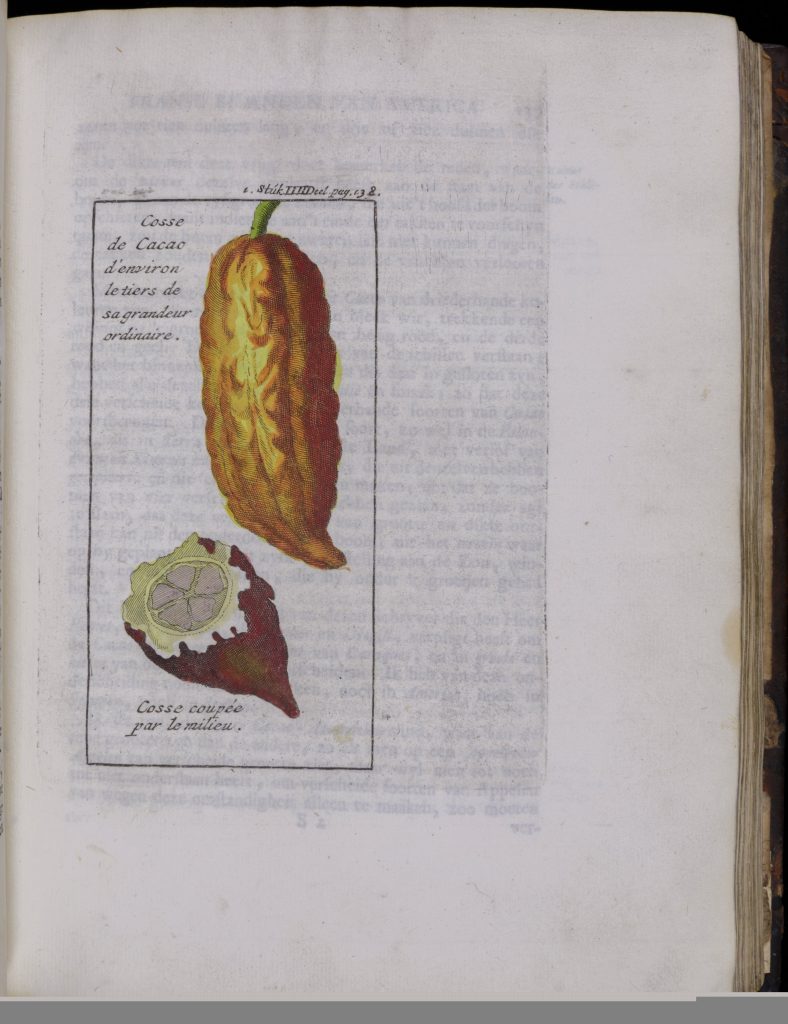
Although chocolate was unknown to Europeans before the discovery of the Americas, it quickly found its way onto tables of the elite. This product of the Columbian Exchange was consumed in the Americas for thousands of years prior to its first introductions to Spain by explorers and missionaries in the first half of the sixteenth century. People originally indulged in chocolate as a beverage, combining a paste of roasted cacao beans with water and other flavorings. The mixing process was an elaborate one, complete with distinct vessels and equipment for producing the beverage’s particular texture.
Because of Spanish colonial and missionary activities, chocolate was first popular among the Spanish aristocracy. But soon, other European elites began to crave chocolate. As a new, exotic, rare, and expensive commodity, chocolate was a high-status beverage. When combined with similarly exotic and expensive ingredients, such as sugar and spices, chocolate became the ultimate luxury drink. Colonial powers relied upon local and imported slaves to harvest and process cacao, a notoriously labor-intensive crop. The reliance upon slave labor coincided with complementary crops that flourished in New World colonies like sugar, coffee, and tobacco.
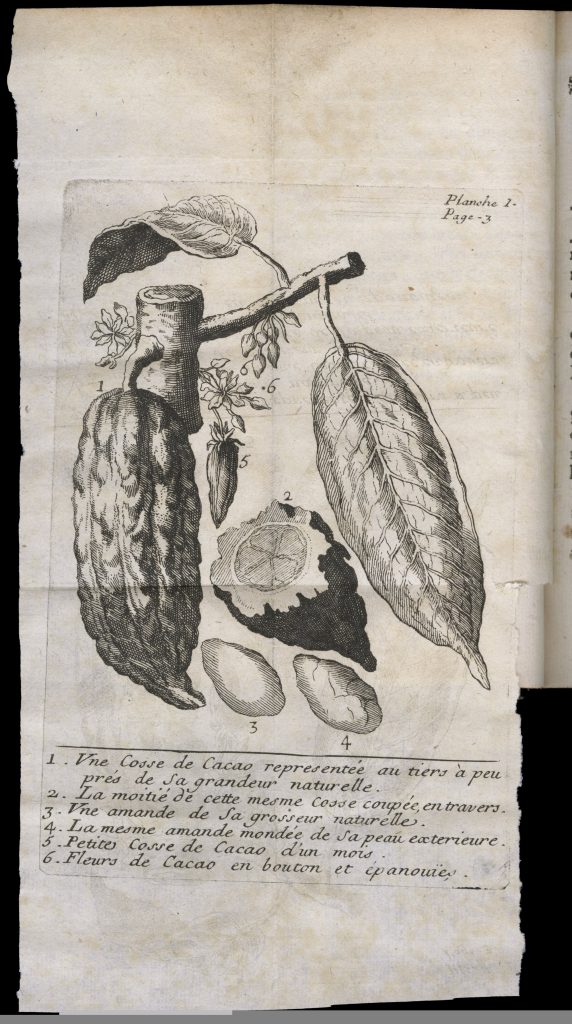
As chocolate became widely known and consumed throughout Europe, everyone seemed to publicize their opinions about it. Cacao appeared in discussions of economic matters by kings and parliaments, as it was a highly profitable good for European imperial powers. Physicians touted chocolate’s medical benefits. In fact, entire treatises were printed on this very topic. Various preparations and ingredients could tailor the drink to ease specific ailments. Chocolate even found its way into religious debates during the sixteenth and seventeenth centuries. Two orders within the Catholic Church, the Jesuits and Dominicans, clashed over whether it could be ingested during periods of religious fasting. Writings about chocolate were printed throughout Europe in multiple languages, including Dutch, English, French, German, and Spanish. These texts explored the medical and commercial value, religious implications, and the pleasure of chocolate in the Old and New Worlds.
In the early nineteenth century, new technologies were developed to industrialize the processing of cacao and manufacturing of chocolate products. Mechanical processing increased the number of products which could be produced from cacao, including Dutch process cocoa, cacao butter, and milk chocolate. Decades of new innovations led to chocolate as the food we know today, consumed in a solid form, as syrups and powders with milk, and combined with sugary concoctions like caramel and marshmallows in inexpensive treats. Knowing the complex past of chocolate helps us see that even the most ordinary of foods has an extraordinary history.
Essential Questions
- In what ways did indigenous peoples of the Americas view cacao? How did Europeans view cacao? How did these views shape interactions with indigenous peoples and trade between the Americas and Europe?
- How was cacao used and consumed by indigenous peoples and Europeans?
- What information did travelers, missionaries, and colonists relay to other Europeans about cacao? Why did they present that information?
Cacao from the New World: A Botanical Exploration
Until the eighteenth century, explorers, travelers, and missionaries were typically so astounded by the people, land, and natural resources in the New World that they recorded their accounts and published them when they returned to Europe. Tens of volumes were created by such authors, although the writers had a variety of intentions for printing their accounts. Some sought fame, others desired more professional expertise, while others sought more European financial interests in the New World. Regardless of their goals and intended audiences, many of these authors left us valuable early descriptions of resources, like cacao. Some publications contained only text, and were therefore easy to produce and cheaper to sell. Still others contained woodcuts and engravings, sometimes brightly colored, piquing interest in these exotic new foods and drinks.
Selection: William Hughes, The American physitian, or, A treatise of the roots, plants, trees, shrubs, fruit, herbs, &c. growing in the English plantations in America : describing the place, time, names, kindes, temperature, vertues and uses of them, either for diet, physick, &c (1672).
Many writers focused, at least in part, on botanical descriptions. The following descriptions of cacao are excerpts from larger sections on the plant. Hughes wrote about the size, shape, growing conditions, etc. of cacao, while Labat’s work includes elaborate and colorful engravings. Hughes, a British physician who traveled to Jamaica, recorded his observations about New World botanical life. His description of cacao is among the longest in the book, also suggesting recipes and medical uses. Both also detail additional information which is not included here about the native uses, European culinary and medical applications, and cultivation techniques. Hughes’s book was printed in his native England, while Labat’s, a French priest, was published in the Netherlands in Dutch with occasional French text and captions. Both Hughes and Labat spent considerable time traveling in the Caribbean; this allowed them to produce more detailed work than other writers.
Hughes and Labat use different media to depict the cacao and thus their descriptions relay different amounts of information. Observe how Hughes labors over growing and harvesting instructions and various terminologies. This is typical for descriptions of the features of cacao in many contemporary sources, including the text in Labat. While useful, this contrasts dramatically with the visual depiction in Labat’s volume. This work is a Dutch translation of the journals of Labat from his extensive travels on the islands of the Caribbean in the 1690s. Note the extraordinarily detail of the images. The color, especially, was a rarity for the time.
Selection: Jean Baptiste Labat, Nieuwe reizen naar de Franse eilanden van America (1725).
Questions to consider:
- Note the particular characteristics of cacao each author emphasizes. Their styles and presentation are very different; who are their audiences? What role does language play? Is one depiction more effective than another? Do the authors give any clues about their intentions?
- Hughes wrote a single-volume book, while Labat’s journals were divided into a multi-volume set with very large books. As part of a general interest in the scientific aspects of the world (and universe) Many contemporary books about the natural world were being produced as multi-volume sets, containing similar types of images and descriptions. Despite seeing only two images from Labat’s work, what can you surmise about Labat and his publisher? How did they fit into a broader publishing trend?
- When examining these sources, consider that Hughes and Labat also conveyed similar information about many other exotic items now familiar around the world, including corn, potatoes, chili peppers, and banana. Does this change the context of the sources? Do you think the sections about cacao would still seem important or notable?
- What do we learn about the cacao tree and pods? How would this information be valuable to Europeans, who do not live in a climate conducive to growing this crop? Might it be related to a desire to promote European cultivation of the plant in the New World?
Imagining Chocolate’s Exotic Origins
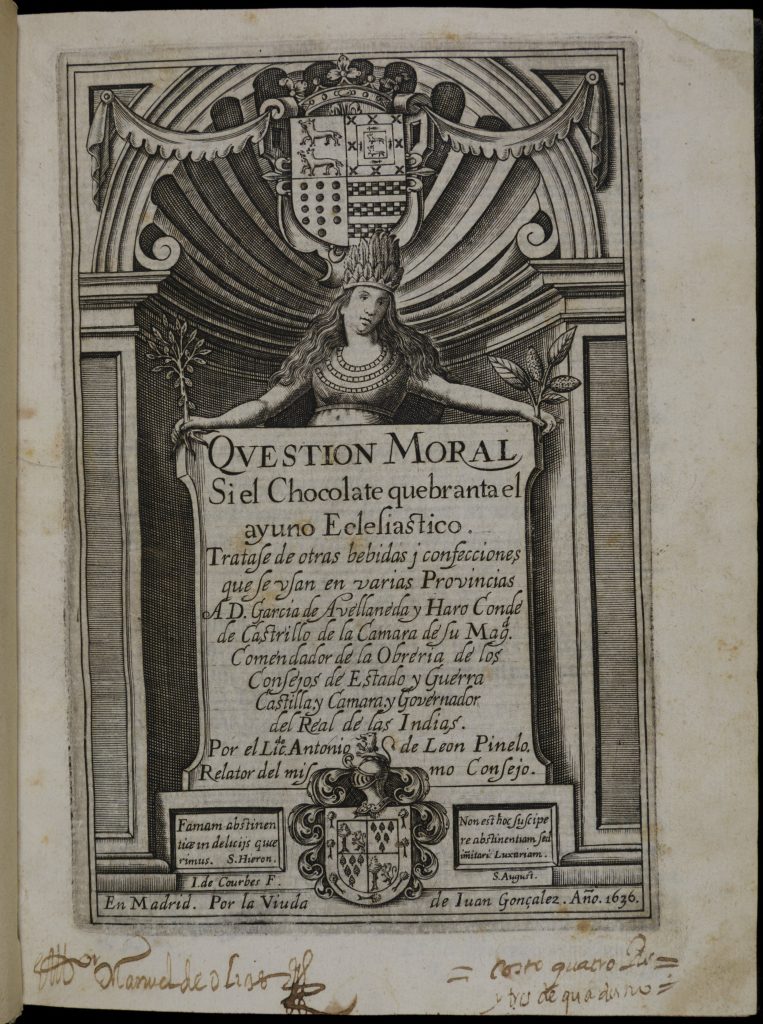
When the exotic beverage made from cacao made its way to Europe, drinking chocolate quickly became popular in noble courts throughout England and the Continent. Europeans were interested in this new drink, and travelers who encountered it in the Americas were more than happy to provide detailed information about their experiences. A wide range of sources described chocolate’s exotic origins: travel accounts, books about foods and drinks, maps, and more. The sources in this section fall into these categories, all produced at different times for different audiences, yet each conveying distinct information about the American origins of one of Europe’s favorite beverages. The image to the left is the decorative title page of a book that was part of the European debate about the morality of drinking chocolate during periods of fasting in the Catholic Church. It depicts an Indigenous woman holding a cacao plant and a cacao branch with pods.
European travel accounts, in particular, are closely related to the previous section’s sources. In fact, there is some overlap in the types of information they provide about cacao. However, Benzoni and Acosta’s books, excerpted below, include more indigenous cultural and ceremonial information. Acosta even provides a lengthy account of an indigenous religious ceremony involving chocolate which is not included here. Benzoni describes the cacavate, or cacao, in Mexico and includes an image of cacao pods drying on a mat. He recounts his own experience drinking it, first criticizing it as a drink for pigs, then stating it was satisfying and refreshing.
Selection: Girolamo Benzoni, La historia del Mondo Nuovo (1565).
Translation of excerpt from Benzoni, La historia del Mondo Nuovo:
The other is cacavate, which they use as money, and is produced on a moderately sized tree, that flourishes only in very warm and shady localities; for if shone upon by the sun, it would die. It is therefore planted in the woods in moist places, and this not being sufficient, they plant a tree near it that grows larger, and when it has reached a sufficient height, they double down its head so as to shelter the other and shade it, preventing the sun from giving it any annoyance.
The fruit is like almonds, lying in a shell resembling a pumpkin in size. It ripens in the course of a year, and being plucked when the season has arrived, they pick out the kernels and lay them on mats to dry; then when they wish for the beverage, they roast them in an earthen pan over the fire, and grind them with the stones which they use for preparing bread. Finally, they put the paste into cups, made out of the calabashes produced by a certain tree that grows all over India; and mixing it gradually with water, sometimes adding a little of their spice, they drink it, though seeming more suited for pigs than for men.
I was upwards of a year in that country without ever being induced to taste this beverage; and when I passed through a tribe, if an Indian wished occasionally to give me some, he was very much surprised to see me refuse it, and went away laughing. But subsequently, wine failing, and unwilling to drink nothing but water, I did as others did. The flavor is somewhat bitter, but it satisfies and refreshes the body without intoxicating: the Indians esteem it above everything, wherever they are accustomed to it.
Translation from William Henry Smyth, History of the New World (London: Printed for Hakluyt Society, 1857), 149–50.
These images and descriptions promote exoticism to heighten differences between indigenous Americans and Europeans. This helps promote a sense of superiority for European audiences and provides a justification for the social, economic, and cultural distinctions they promote as they colonize the New World and establish plantations and a system of slavery to produce and export their favorite goods. The exotic depictions in part imagine a faraway land with unusual and mysterious customs, but also make those customs (like the preparation of cacao into drinking chocolate) known to European audience and promote the very drink which has become popular in Europe.
As a Jesuit missionary, Acosta travelled through New Spain for fifteen years before returning to Europe. His book describes indigenous customs; climate; bodies of water; and plant, animal, and mineral resources in the New World.
Selection: Jose de Acosta, Histoire natvrelle et moralle des Indes, tant Orientalles qu’Occidentalles (1598).
Translation of excerpt from de Acosta, Histoire natvrelle et moralle des Indes, tant Orientalles qu’Occidentalles:
It is so much prized among the Indians, and even among Spaniards, that it is one of the richest and most frequent objects of trade in New Spain; for because it is a dry fruit it can be kept for a long time without loss and ships loaded with it are brought from the province of Guatemala. And this past year an English pirate burned more than a hundred thousand loads of cacao in the port of Huatulco in New Spain. It is also used as money, for with five cocoa beans one thing can be bought, and with thirty another, and with a hundred another, and without haggling; and it is customary to give cocoa beans to the poor when they ask for alms.
The chief value of this cocoa is a beverage that they make called chocolate, which is prized to the point of folly in that land. It is nauseating to some who are not accustomed to it, for it has froth on top and a sort of lees, which indeed require a good deal of effort to drink. Yet it is the most prized drink and is offered to noblemen as they pass through their lands. Both Indians and Spaniards, and especially Spanish women who have grown accustomed to the land, adore their black chocolate. They say that this chocolate is made in different forms and temperatures: hot and cold and lukewarm. They often put spices in it and much chile; they also make it in the form of a paste, and say that it is good for the chest and stomach and against catarrh. No matter what its uses, those who have not been brought up to it do not much care for it.
Translation from Jane Mangan, ed. Natural and Moral History of the Indies, translated by Frances M. López-Morillas (Durham: Duke University Press, 2002), 209-210.
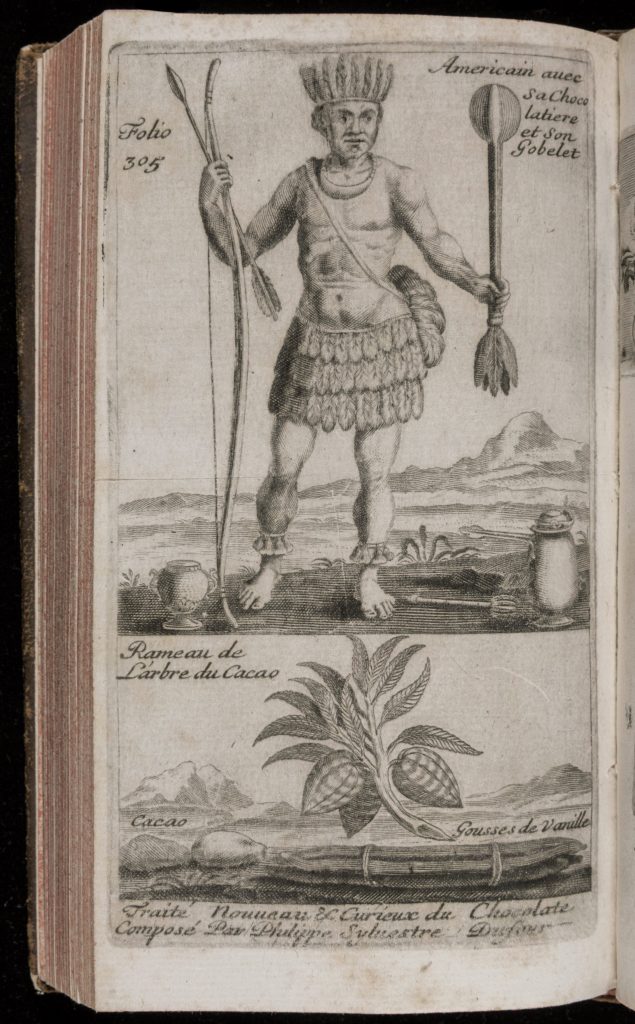
The authors and artists in this section spent varying amounts of time in the Americas. Pinelo, Benzoni, and Acosta each lived and traveled in the Americas extensively; they each produced lengthy textual descriptions of their experiences, including their interactions with Cacao. Dufour did not spend any time in the New World, yet Dufour’s treatise on several exotic caffeinated drinks (coffee, tea, and chocolate) is accompanied by images based on secondhand accounts and not firsthand knowledge. The engraving on the right depicts a man symbolizing chocolate and immediately precedes a lengthy description of the drink. Observe the implements at his feet associated with preparing chocolate, as well as the botanical images at the bottom of the page. Consider how this variation might result in different levels of accuracy.
Questions to consider:
- What did Europeans think of drinking chocolate? Does this view seem consistent among sources? How does this relate to how people viewed indigenous Americans who drank this beverage?
- How did indigenous peoples and Europeans value cacao? Even as early as the sixteenth century, was very much making its way to Europe?
- How was drinking chocolate related to social status? What status of Europeans and indigenous peoples drank this beverage?
- What can we learn about the process of preparing harvested cacao pods and making it into a drink from the images in these sources? What kinds of tools are needed to prepare and drink the beverage? Do the implements differ between the images produced at different dates and for different audiences?
- Do you think the authors and illustrators were accurate? Explain why or why not.
European Interpretations of Chocolate
Spanish explorers, missionaries, and colonists in the New World embraced drinking chocolate after adapting it to their own tastes. They interpreted the beverage to fit more familiar flavors, spices, temperatures, and methods. The Spanish made a few important changes before transporting the drink to Europe in the sixteenth century: they served chocolate hot, not cold; sweetened it with cane sugar, added Old World spices like cinnamon, anise, and black pepper rather than chili, maize, and other New World products; and produced a froth with a special stirring stick called a molinillo rather than relying on the pouring method the indigenous peoples used. These changes produced a drink irresistible to the noble European palate. Once in Europe, each region embraced slightly different flavors, preparation methods, and servingware.
Chocolate was radically different from any other beverage available in Europe at the time. It entered the market at about the same time as tea and coffee; this was the first exposure most Europeans had to caffeine. Numerous authors commented on chocolate’s side effects causing alertness, mental clarity, and promoting digestion. Physicians were fascinated with this new food, observing its effects and trying to codify its characteristics and uses as medical drug. The prevailing medical system of the time, called humoral theory, the body and all foods and medicines had specific properties, or humors. A body’s humors had to be balanced or else a person would become sick. One could consume foods, drinks, and medicines with humors to balance bodily humors. Chocolate had the ability to balance many different humors, depending upon if the drink was hot or cold, or if it was mixed with other ingredients.
The authors presented in this section authored major treatises on chocolate, devoting large sections on its culinary and medical preparations. There are substantial differences between them, however. Stubbe’s book was published in seventeenth-century England, while Quélus printed his treatise in eighteenth-century France. Stubbe was an English physician, and his book is a medical discussion of chocolate and a critique of other physicians’ assessments. One of Stubbe’s goals is to convince England that chocolate is a powerful medicine and he is the country’s expert on it. Stubbe copied, referred to, and refuted the work of many contemporary physicians around Europe. Quélus, on the other hand, stated in his preface that he wanted to create an original work based entirely on his observations. He lived in the French American islands for fifteen years. While there, he carefully observed cacao as a plant and product. The book contains his diagrams as well as textual descriptions, medical virtues, and culinary and medical preparations. He combined botanical descriptions and diagrams with firsthand accounts of cacao preparation in the Americas as well as his own extensive medical observations. Quélus’s treatise can also be compared to the other travel accounts describing chocolate listed above.
Selection: Henry Stubbe, The Indian nectar, or, A discourse concerning chocolata (1662).
Selection: D. Quélus, Histoire naturelle du cacao, et du sucre, divisée en deux traités (1719).
Translation of excerpt from Quélus, Histoire naturelle du cacao, et du sucre, divisée en duex traités, Plate 1:
1. A cacao pod depicted at approximately one third of its natural size.
Translated by the author
2. Half of this same pod cut across.
3. A bean of its natural size.
4. The same bean hulled from its outer skin.
5. Small cacao pod at one month.
6. Cacao flowers in bud and blooming.
Translation of excerpt from Quélus, Histoire naturelle du cacao, et du sucre, divisée en duex traités, 97-100:
The Indians, who have used this Drink time out of mind, prepared it without any great Art; they roasted their Kernels in earthen Pots, then ground them between two Stones, diluted them with hot Water, and season’d them with Pimento: those who were more curious, added Achiota to give it a Colour, and Attolla to augment its Substance. All these things joined together, gave to the Composition so strange a Look, and so odd a Taste, that a Spanish Soldier said, it was more fit to be thrown to Hogs, than presented to Men; and that he could never have accustomed himself to it, if the want of Wine had not forced him to it, that he might not always be obliged to drink nothing but Water.
The Spaniards taught by the Mexicans, and convinced by their own Experience, that this Drink, as rustick as it appeared to them, nevertheless yielded very wholesome Nourishment; try’d to make it more agreeable by the Addition of Sugar, some Oriental Spices, and Things that grew there, which it will be needless to mention, because the Names of them are not so much as known here, and because of so many Ingredients, there is none continued down to us but Vanilla; in like manner, that Cinnamonis the only Spice which has had general Approbation, and remains in the Composition of Chocolate.
Vanilla is a Cod of a brown Colour and delicate Smell; it is flatter and longer than our [French] Beans, it contains a luscious Substance, full of little black shining Grains. They must be chosen fresh, full, and well grown, and care must be taken that they are not smeared with Balsam, nor put in a moist Place.
The agreeable Smell, and exquisite Taste that they communicate to Chocolate, have prodigiusly recommended it; but long Experience having taught that it heats very much, its Use is become less frequent, and those who prefer their Health more than pleasing their Senses, abstain from it entirely. In Spain and Italy, Chocolate prepared without Vanilla, is called at present Chocolate of Health; and in the French Islands of America, where Vanilla is neither scarce nor dear, as in Europe, they do not use it at all, though they consume as much Chocolate there as in any other Place in the World.
Translation from R. Brookes, The Natural History of Chocolate (London: Printed for D. Browne, 1725), 63-65.
Translation of excerpt from Quélus, Histoire naturelle du cacao, et du sucre, divisée en duex traités, 115-116:
5. The Use of Milk is a specifick Remedy for the Cure of several Distempers, but by Misfortune there are but few Stomachs that can bear it, and several Methods have been try’d to find out Help for this Inconvenience. Without troubling myself to mention or examine them, will it not be an easy and natural Method, to hinder the Milk from curdling on the Stomach, to pour a hot Dish of Chocolate upon a Pint or Quart of Milk? The butirous Parts of the Milk and Chocolate, are in reality analogous to each other, and very proper to be united for the same Purpose; and what is bitter and alkaline in the Chocolate, ought necessarily to hinder the curdling of the Milk in the Stomach. It is easy to confirm by Experience the Reasoning upon this sort of Chocolated Milk
Translation from R. Brookes, The Natural History of Chocolate (London: Printed for D. Browne, 1725), 74.
Questions to consider:
- Stubbe and Quélus discuss the culinary and medical preparations of chocolate, but do so in different centuries and for different audiences. What similarities and differences are present in their writings?
- What sorts of medical preparations do different physicians recommend? What kinds of culinary preparations are described? Is it difficult to tell the difference between the culinary and the medical?
- Which “recipes” seem the most modern? How does the preparation of chocolate differ from the forms you know today? What are differences between indigenous and European preparations?
- Note the chocolate milk recipe. Is it a drink to enjoy? Or a medicine? What does the author think about “chocolated milk”? Is it risky to drink it?
Early European Encounters with Cacao
Many writers who documented early European encounters with cacao in the Americas included botanical descriptions and illustrations, captured in these texts by Labat, Hughes, and Quélus.
European Accounts of Chocolate’s Origins
As Europeans became increasingly interested in chocolate, a wide range of sources produced by travelers emerged describing chocolate’s origins, which included accounts of indigenous cultures and contributed to the exoticization of these populations.
European Interpretations of Chocolate
As chocolate rapidly grew in popularity in Europe, numerous authors commented on its effects, with these writings by Stubbe and Quélus examples of works written about chocolate’s culinary and medical preparations and potential.
Further Reading
Sophie Coe and Michael Coe, The True History of Chocolate (Thames & Hudson, 1996).
Rebecca Earle, The Body of the Conquistador (Cambridge University Press, 2014).
Louis E. Grivetti and Howard-Yana Shapiro, Chocolate: History, Culture, and Heritage (John Wiley & Sons, 2011).
Marcy Norton, Sacred Gifts, Profane, Pleasures: A History of Tobacco and Chocolate in the Atlantic World (Cornell University Press, 2008).




